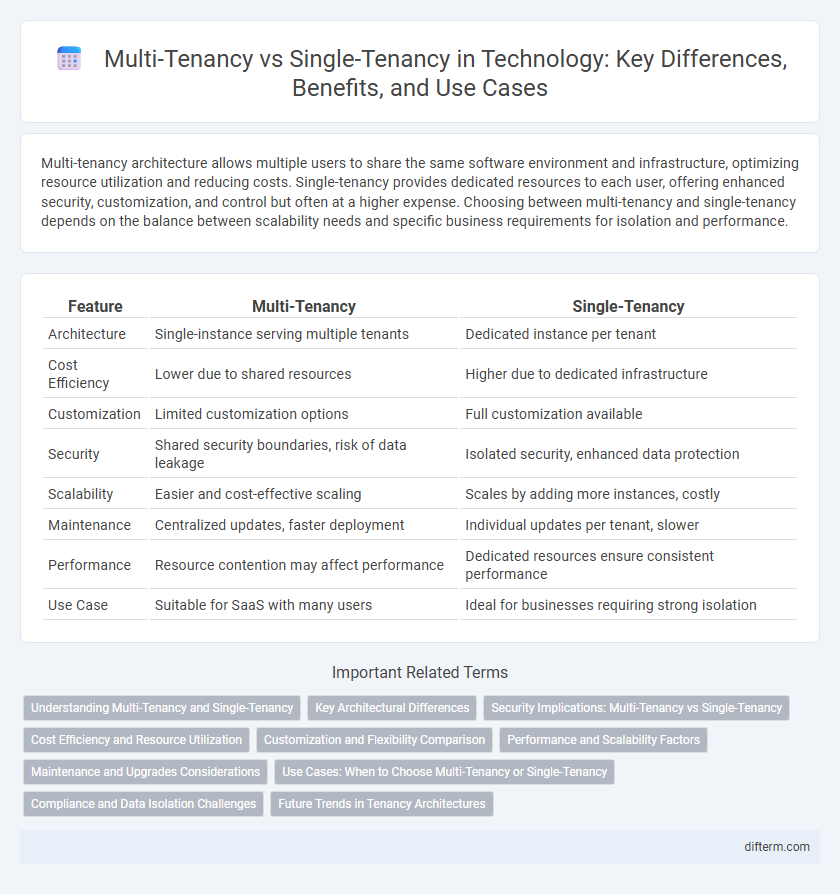Multi-tenancy architecture allows multiple users to share the same software environment and infrastructure, optimizing resource utilization and reducing costs. Single-tenancy provides dedicated resources to each user, offering enhanced security, customization, and control but often at a higher expense. Choosing between multi-tenancy and single-tenancy depends on the balance between scalability needs and specific business requirements for isolation and performance.
Table of Comparison
| Feature | Multi-Tenancy | Single-Tenancy |
|---|---|---|
| Architecture | Single-instance serving multiple tenants | Dedicated instance per tenant |
| Cost Efficiency | Lower due to shared resources | Higher due to dedicated infrastructure |
| Customization | Limited customization options | Full customization available |
| Security | Shared security boundaries, risk of data leakage | Isolated security, enhanced data protection |
| Scalability | Easier and cost-effective scaling | Scales by adding more instances, costly |
| Maintenance | Centralized updates, faster deployment | Individual updates per tenant, slower |
| Performance | Resource contention may affect performance | Dedicated resources ensure consistent performance |
| Use Case | Suitable for SaaS with many users | Ideal for businesses requiring strong isolation |
Understanding Multi-Tenancy and Single-Tenancy
Multi-tenancy architecture allows multiple customers to share a single instance of software, optimizing resource utilization and reducing operational costs. Single-tenancy provides dedicated software instances per customer, enhancing security and customization but often increasing maintenance complexity. Choosing between multi-tenancy and single-tenancy depends on factors like scalability, tenant isolation, and cost-efficiency in cloud computing environments.
Key Architectural Differences
Multi-tenancy architecture enables multiple tenants to share a single application instance and database, optimizing resource utilization and lowering operational costs. Single-tenancy architecture isolates each tenant with dedicated application instances and databases, providing higher customization and enhanced security at the expense of increased infrastructure requirements. The choice between multi-tenancy and single-tenancy depends on factors such as scalability, performance, data isolation, and compliance needs.
Security Implications: Multi-Tenancy vs Single-Tenancy
Multi-tenancy environments share resources among multiple users, increasing the risk of data breaches due to potential cross-tenant vulnerabilities and complex access control. Single-tenancy provides dedicated resources per user, significantly reducing attack surfaces and enhancing data isolation for sensitive applications. Compliance requirements such as HIPAA or GDPR often favor single-tenancy models to ensure stricter security measures and better audit trails.
Cost Efficiency and Resource Utilization
Multi-tenancy architecture significantly reduces operational costs by sharing infrastructure and maintenance across multiple users, optimizing resource utilization and maximizing server capacity. Single-tenancy systems require dedicated resources for each client, leading to higher expenses in hardware, software licensing, and ongoing support. Cloud providers often promote multi-tenancy for cost-efficient scalability while still addressing security through tenant isolation techniques.
Customization and Flexibility Comparison
Multi-tenancy offers limited customization options since multiple users share the same software instance, restricting flexibility to individual tenant requirements. Single-tenancy provides extensive customization and greater control, allowing each tenant to tailor the application, environment, and security settings according to specific business needs. Enterprises prioritizing unique workflows and scalable integrations benefit more from single-tenant architectures due to their adaptability and isolated configuration capabilities.
Performance and Scalability Factors
Multi-tenancy architectures improve scalability by enabling resource sharing across multiple users, reducing infrastructure costs and optimizing server utilization. Single-tenancy systems often deliver higher performance per tenant due to dedicated resources but face challenges in scaling efficiently as the user base grows. Cloud platforms optimize multi-tenant environments with load balancing and dynamic resource allocation to maintain consistent performance under varying workloads.
Maintenance and Upgrades Considerations
Multi-tenancy architecture simplifies maintenance and upgrades by allowing centralized updates, reducing downtime and operational costs across all tenants simultaneously. Single-tenancy environments require individual maintenance for each instance, increasing complexity and resource allocation for upgrades. Choosing multi-tenancy enhances scalability and ensures faster deployment of patches and improvements, critical for continuous technology innovation.
Use Cases: When to Choose Multi-Tenancy or Single-Tenancy
Multi-tenancy is ideal for SaaS providers targeting cost efficiency and scalability, allowing multiple customers to share the same infrastructure while maintaining data isolation. Single-tenancy suits organizations needing enhanced security, customization, and performance, such as financial institutions or healthcare providers handling sensitive data. Enterprises with dynamic user bases or strict compliance requirements should weigh multi-tenancy's operational ease against single-tenancy's dedicated resources.
Compliance and Data Isolation Challenges
Multi-tenancy architectures pose significant challenges for compliance due to shared resources and data isolation requirements across multiple clients, increasing the risk of unauthorized access. Single-tenancy environments offer stronger data isolation by dedicating hardware and software resources to a single organization, simplifying adherence to regulations like GDPR, HIPAA, or PCI-DSS. Ensuring robust encryption, access controls, and audit trails is critical in both models to maintain compliance and protect sensitive information effectively.
Future Trends in Tenancy Architectures
Future trends in tenancy architectures emphasize hybrid models combining the scalability of multi-tenancy with the security benefits of single-tenancy, driven by advancements in cloud-native technologies and containerization. Edge computing integration enhances real-time data processing for multi-tenant platforms, while AI-powered tenant isolation improves resource allocation and threat detection. Increased adoption of serverless architectures and microservices further optimizes tenancy flexibility and operational efficiency.
multi-tenancy vs single-tenancy Infographic

 difterm.com
difterm.com